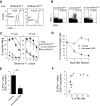NK-cell-mediated killing of target cells triggers robust antigen-specific T-cell-mediated and humoral responses
- PMID: 19406986
- PMCID: PMC2710917
- DOI: 10.1182/blood-2009-01-201467
NK-cell-mediated killing of target cells triggers robust antigen-specific T-cell-mediated and humoral responses
Abstract
Previous work showed that administration of antigen-expressing apoptotic cells in vivo results in antigen-specific CD8+ T-cell responses independent of Toll-like receptor signaling. We report here that natural killer (NK) cells can serve a function directly upstream of this pathway and initiate robust adaptive immune responses via killing of antigen-expressing target cells. This pathway is highly sensitive, in that administration of as few as 10(4) target cells induced detectable antigen-specific CD8+ T-cell responses. Importantly, NK cell-mediated cytotoxicity of target cells could also induce robust antigen-specific CD4+ T-cell responses, which were critical for subsequent CD8+ T-cell priming and IgG responses. Unlike adaptive immune responses induced by gamma-irradiated cells, the NK-cell pathway required myeloid differentiating factor 88 (MyD88) and Toll/interleukin-1 receptor domain-containing adapter-inducing interferon-beta (Trif) signaling. NK cells have previously been shown to detect and kill pathogen-infected host cells, as well as neoplastic cells and tissue allografts. The present data provide further evidence that they also discharge a strong tie with their relatives in the adaptive immune system. We think that the recognition and killing of target cells by NK cells represents an important pathway for the generation of robust CD8+ T and humoral responses that may be exploited for vaccine development.
Figures






Similar articles
-
TLR4- and TRIF-dependent stimulation of B lymphocytes by peptide liposomes enables T cell-independent isotype switch in mice.Blood. 2013 Jan 3;121(1):85-94. doi: 10.1182/blood-2012-02-413831. Epub 2012 Nov 8. Blood. 2013. PMID: 23144170
-
Activation of natural killer T cells by alpha-galactosylceramide rapidly induces the full maturation of dendritic cells in vivo and thereby acts as an adjuvant for combined CD4 and CD8 T cell immunity to a coadministered protein.J Exp Med. 2003 Jul 21;198(2):267-79. doi: 10.1084/jem.20030324. J Exp Med. 2003. PMID: 12874260 Free PMC article.
-
Nanoparticle adjuvant sensing by TLR7 enhances CD8+ T cell-mediated protection from Listeria monocytogenes infection.J Immunol. 2014 Feb 1;192(3):1071-8. doi: 10.4049/jimmunol.1302030. Epub 2013 Dec 27. J Immunol. 2014. PMID: 24376264
-
NK-like CD8 T cell: one potential evolutionary continuum between adaptive memory and innate immunity.Clin Exp Immunol. 2024 Jul 12;217(2):136-150. doi: 10.1093/cei/uxae038. Clin Exp Immunol. 2024. PMID: 38651831 Free PMC article. Review.
-
Illuminating the petite picture of T cell memory responses to Listeria monocytogenes.Biomed Res Int. 2013;2013:121684. doi: 10.1155/2013/121684. Epub 2013 Sep 22. Biomed Res Int. 2013. PMID: 24171157 Free PMC article. Review.
Cited by
-
Intratumor Regulatory Noncytotoxic NK Cells in Patients with Hepatocellular Carcinoma.Cells. 2021 Mar 10;10(3):614. doi: 10.3390/cells10030614. Cells. 2021. PMID: 33802077 Free PMC article.
-
Potential value of efficacy prediction and treatment of natural killer cells in extensive stage small cell lung cancer.Thorac Cancer. 2023 Apr;14(10):864-872. doi: 10.1111/1759-7714.14837. Epub 2023 Mar 1. Thorac Cancer. 2023. PMID: 36861174 Free PMC article. Review.
-
Editorial: Lymphocyte Functional Crosstalk and Regulation.Front Immunol. 2019 Dec 10;10:2916. doi: 10.3389/fimmu.2019.02916. eCollection 2019. Front Immunol. 2019. PMID: 31921175 Free PMC article. No abstract available.
-
Intratumoral co-injection of NK cells and NKG2A-neutralizing monoclonal antibodies.EMBO Mol Med. 2023 Nov 8;15(11):e17804. doi: 10.15252/emmm.202317804. Epub 2023 Oct 2. EMBO Mol Med. 2023. PMID: 37782273 Free PMC article.
-
Adenovirus Vector Vaccination Impacts NK Cell Rheostat Function following Lymphocytic Choriomeningitis Virus Infection.J Virol. 2018 May 14;92(11):e02103-17. doi: 10.1128/JVI.02103-17. Print 2018 Jun 1. J Virol. 2018. PMID: 29514912 Free PMC article.
References
-
- Blankenstein T. The role of inflammation in tumour growth and tumour suppression. Novartis Found Symp. 2004;256:205–210. - PubMed
-
- Gallucci S, Lolkema M, Matzinger P. Natural adjuvants: endogenous activators of dendritic cells. Nat Med. 1999;5:1249–1255. - PubMed
-
- Degli-Esposti MA, Smyth MJ. Close encounters of different kinds: dendritic cells and NK cells take centre stage. Nat Rev Immunol. 2005;5:112–124. - PubMed
-
- Kelly JM, Darcy PK, Markby JL, et al. Induction of tumor-specific T cell memory by NK cell-mediated tumor rejection. Nat Immunol. 2002;3:83–90. - PubMed
Publication types
MeSH terms
Substances
Grants and funding
LinkOut - more resources
Full Text Sources
Other Literature Sources
Molecular Biology Databases
Research Materials
Miscellaneous

